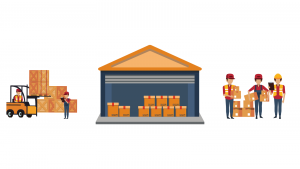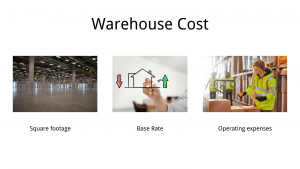Your Strategic Partner for
Unlocking China's Sourcing Potential
How Much does the China Warehouse Cost?
Are you looking to rent a warehouse in China?
Do you need clarification about the cost of renting one?
If so, this detailed article has the answer for you.
Keep reading, and you’ll get a clear idea of the price.
If you run a brand, your products need a warehouse. That’s because your product range might increase over time. You’ll have to invest in larger storage solutions to organize orders. You may need extra space for your team to move around.
Spend some time looking for the ideal warehouse for your business. Consider all expenses and factors involved in renting a warehouse.
In this article, I’ll discuss renting costs in 3 main states of China. I’ll also explore the factors that influence warehousing costs. In the end, I’ll tell you how to calculate the price.
1. How much does it cost to rent a warehouse in China?
Mostly, when renting warehouse space, you’ll pay by square meters. A warehouse cost $21 per square meter each month in Q4 of 2021. It was up from $18 per square meter each month in Q4 2020. This isn’t always the case, but it’s generally the case.

Identify your storage needs before signing any contracts. For example, consider your product. Do you have palletized products you can stack? Does your inventory come in different shapes and sizes? This helps determine how much horizontal and vertical space you need.
It’s also important to consider where your inventory comes from. Do your products arrive on pallets? If so, your warehouse will need a loading dock and a forklift.
You’ll need a large space if your inventory is shipped in large containers. That’s because you’ll need enough space to accommodate container movement.
So, knowing your needs and warehouse logistics is quite crucial. It helps you find real estate to meet these requirements.
2. The most popular exporting city warehouses cost
As many factors affect your warehouse costs, one can’t estimate exactly. Some spaces charge $2.5 per square meter for monthly rent. However, others cost $30 per square meter per month. Prices also vary in different Chinese states. Let’s discuss pricing in 3 big cities:
1)Warehouse For Rent in Shanghai
In Q3 2020, warehouse rents in Shanghai remained at $4 per sqm monthly. For both bonded and non-bonded warehouses, rents reached $6. And the prices now have increased by around 6.5%.

2)Warehouse For Rent Guangzhou
A warehouse in Guangzhou typically monthly rents for between $5 and $15. However, many prevailing factors impact the charges. So, it’s important to recognize that they may differ.
3)Warehouse For Rent Shenzhen
The average monthly rent for a warehouse in Shenzhen warehouse is:
- $15 per square meter for 1 to 99 square meters.
- $13 per square meter for 100 and above square meters.
Note that the cost of rent in Shenzhen warehoused fluctuates. It varies from one location to the other. This is just an estimation, and the prices are negotiable.
3. What factors influence the cost of renting a warehouse?
As mentioned earlier, warehouse rental prices come with a lot of variances. This makes it difficult to know the exact cost. You don’t know how much a warehouse rents exactly. There are several factors influencing the overall cost. But the primary among them are:
- Dimensions
- Base rate
- Operating expenses
1)Let’s elaborate on dimensions first in detail.
Dimensions mean how many meters per square area you rent. It has a huge impact on the amount you’ll pay as rent. Ultimately, renting a space is determined by how much space you need. So, there are small and large warehouses with low and high prices.
Small warehouses are those with less than 30 square meters. They tend to be more cost-effective than bigger storage facilities. eCommerce retailers often partner with these smaller locations. They can store their inventory without an excessive footprint.
Large warehouses are those with more than 100 square meters. They are often used by importers, exporters, manufacturers, and wholesalers. Facilities with this much space are usually located in industrial areas. They provide quick access to highways and loading docks.
2)Let’s talk about the base rate.
The base rate is the set rate your company pays the landlord. You’ll have to pay all the additional operating costs separately. You might get charged monthly, quarterly, or yearly per square meters. It depends on your preference to rent a warehouse for a specific duration.
Finally, operating expenses impact the rent of the warehouse.
You need a warehouse for keeping your cargo in stock. It’ll result in higher costs for managing the cargo. Sometimes, you prepare shipment against orders. So, you must repack the cargos. And for this, you need new cartons.

All this requires a huge staff and material to utilize. When you start your warehouse, you’ll have to pay for some stuff. These include:
- Water costs
- Electricity costs
- Security costs
- Insurance charges
- Labor costs
- Cartons costs
Put simply; you’re the one who’s responsible for all operating costs. Your landlord is not responsible for any expenses incurred. You’ll just operate your business on their property.
That was all about the factors that influence warehouse costs. You might have got the idea about the rent to pay. Now, I’ll let you know how to calculate your warehouse rent.
3)Payment by Monthly, Annual or Flexible Plan
To save yourself from extra expenses, estimating warehouse costs is necessary. I’ve broken down these calculations into three different rental options. These are:
- Monthly rate
- Annual rate
- Flexible rate
In the monthly warehouse rental rate, your company is billed monthly.
Suppose you use 185 square meters in a warehouse billed monthly. Let’s also assume the following is true:
Base rate = $2.5 per square meters per month
Add up your base rate plus water, electricity, security, insurance.
So, your brand can expect to pay over $462.50 monthly. You can store your inventory at this rate in the warehouse.
Now, let’s talk about the annual rental rate of a warehouse. So, the annual rate means you get billed annually for the warehouse.
Suppose you use 185 square meters in a warehouse billed annually. Let’s also assume the following is true:
Base rate = $30 per square meters per year
Add up your base rate plus water, electricity, security, insurance.
Multiply the lease rate by your area in meters. It’ll come to $5,550 (185 x $30.00 = $5550).
Accordingly, your brand can expect to pay over $5,550 annually. You can store inventory at this rate in that warehouse.
As you’ve probably realized, annual billing gives you the lowest overall rate. It’s worth considering if your landlord offers annual terms.
Wait, I have another option for you, the flexible rental rate. If you want a warehouse with flexible timing, go for this one. How long you want the storage depends on you. You can store your products for a week, 10 days, and so on.
4. Get the best warehouse to empower your supply chain.
If you’ve difficulties finding the best warehouse, JustChinait can help you. We have been working in China for a decade now. Our China warehousing services can give your business growth a quick boost.
Yes, it’s challenging to work in the Chinese markets and compete. By having a warehouse and managing inventory, you can make things work. Let me give you a quick summary of today’s topic.
China is becoming one of the world’s leading economies. Its exports play a crucial role in progress. In China, warehouses are popping up everywhere due to increased demand for Chinese products. This has led to an increase in warehousing rent and expenses.
The average rent for a warehouse in China is $10 per square meter. And the operating expenses for the same space are about $1.00. As for importers, they’ll have to pay $15 per square meter on average.
The cost is negotiable sometimes, depending on the size of the consignment. For big orders, the Chinese warehouses also offer a discount. Similarly, the price drops when a warehouse is used for a long time.
